“A careful observer can easily see the way in which western cuisine is gaining an increasingly strong influence on Turkish cooking. This influence is taking its place alongside those of ancient Chinese, Persian and Arab civilisations, indigenous Anatolian culture accumulated over many thousands of years, and later still those of Eastern Europe and North Africa. The Turkish cuisine has distilled elements from all these sources without losing touch with its own roots and distinctive identity. As globalisation brings with it an increasing volume of international trade, new fruits, vegetables and spices are finding their way onto the shelves of Turkish supermarkets and grocers shops. At the same time expanding international communications are spearheading a level of cultural exchange never seen before. Even the most conservative cannot remain insulated from this phenomenon, and it is easy to see tha tTurkey will be affected like other societies. Culinary influences will continue to pour in not only from the West but also from Japan and other countries of the Far East. We may also find that newly restored relations with the Turkic republics of Central Asia will result in Turkey rediscovering the cuisines of their ethnic cousins, cuisines which share the same roots but have diverged under disparate influences. The same process of discovery applies to the cuisines of the Mediterranean and China. Over the last few years Americans, Europeans, Japanese and even Australians have begun to discover the Turkish cuisine.”
– Tuğrul Şavkay, Founder, Gastronomy and Culinary Arts Department at Yeditepe University
Buenos Aires – The above quote, and the name of this post, come from Timeless Tastes: Turkish Culinary Culture, a multi-author book project that’s an in-depth and fascinating look into the subject. We got to the world of Turkish cuisine this past weekend via a norteamericano tradition – Thanksgiving, or as it tends to be known colloquially, “turkey day”. Numerous requests for a repeat of last year’s t-day gathering came in, but I wanted to do something different, and when I saw that this weekend was the celebration of Teachers’ Day in Turkey… well, the wheels started to spin, etc., and though no bird of the gobble-gobble sort was in evidence, we had fun exploring some of the flavor combinations that come to us from Turkish cuisine. The book served as my base, I started with five recipes that sounded interesting, and then more or less… screwed around with them.
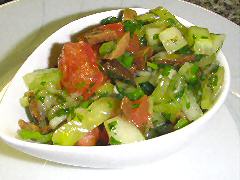 Except in this case, where the original recipe sounded so good I decided not to do anything to it. Kind of gazpacho like, though no added liquid, and heavier on the cucumber than the tomato, this started, and ended, with a recipe for Çoban Salatasi, or Shepherd’s Salad. My proportions were a bit different, as I played around a little with the colors – but it was roughly equal amounts of chopped cucumbers, tomatoes, mild peppers, and green onions. Then, a good amount of thinly sliced radishes, chopped black olives, and a whole lot of chopped parsley. The dressing, equal parts of lemon juice, cider vinegar, and olive oil, with just a bit of salt and black pepper – keeping it somewhat acidic and bright.
Except in this case, where the original recipe sounded so good I decided not to do anything to it. Kind of gazpacho like, though no added liquid, and heavier on the cucumber than the tomato, this started, and ended, with a recipe for Çoban Salatasi, or Shepherd’s Salad. My proportions were a bit different, as I played around a little with the colors – but it was roughly equal amounts of chopped cucumbers, tomatoes, mild peppers, and green onions. Then, a good amount of thinly sliced radishes, chopped black olives, and a whole lot of chopped parsley. The dressing, equal parts of lemon juice, cider vinegar, and olive oil, with just a bit of salt and black pepper – keeping it somewhat acidic and bright.
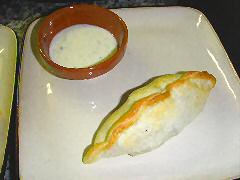 This started off with a recipe that, of course, you’ll all recognize – Zeytinyağli iç Baklali Enginar. Deftly described as “artichokes with broad beans in oil”, it was actually a pretty tasty sounding vegetable side dish of fresh broad beans or fava beans that have been cooked in a pot of salted water with a good dose of olive oil, chopped white onions, and chopped dill. That was then mixed with cooked artichoke hearts that I cut into small pieces… now, the original recipe used the artichoke hearts as a base, a sort of cup, for the beans. I decided to hide them all away inside an empanada skin, and then instead of serving it as a second cold salad dish, bringing them out piping hot. And, how could one have Turkish food without getting some yogurt in somewhere? So, some homemade yogurt with plenty of chopped fresh dill in it, which made a perfect accompaniment to the empanadas.
This started off with a recipe that, of course, you’ll all recognize – Zeytinyağli iç Baklali Enginar. Deftly described as “artichokes with broad beans in oil”, it was actually a pretty tasty sounding vegetable side dish of fresh broad beans or fava beans that have been cooked in a pot of salted water with a good dose of olive oil, chopped white onions, and chopped dill. That was then mixed with cooked artichoke hearts that I cut into small pieces… now, the original recipe used the artichoke hearts as a base, a sort of cup, for the beans. I decided to hide them all away inside an empanada skin, and then instead of serving it as a second cold salad dish, bringing them out piping hot. And, how could one have Turkish food without getting some yogurt in somewhere? So, some homemade yogurt with plenty of chopped fresh dill in it, which made a perfect accompaniment to the empanadas.
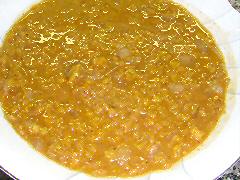 I can’t say that this has anything in common with the original recipe for lentil soup in the book other than using lentils. It was more a distillation of different interesting sounding flavor combinations that appeared in various soups and dishes, many of which used lentils. In the end, it provided some wonderful flavors – I think this might be my new favorite lentil soup – but to the best of my knowledge isn’t remotely traditional. I cooked a couple of chopped red onions in butter until they were soft and translucent. Then I added two teaspoons of smoked paprika and the same of ground sumac berries, and about a tablespoon of tomato paste. I cooked that all until it was starting to lightly brown, then added lentejas turcas as the little red lentils are called here, sauteed them a bit, and then filled the pot with vegetable stock (a meat stock would work fine too if you want, but this came out so well, I probably wouldn’t change it). Cooked it until the lentils were soft and some of them starting to burst, then seasoned with salt and ground mixed peppercorns. Maybe a little yogurt drizzled over the top for color…
I can’t say that this has anything in common with the original recipe for lentil soup in the book other than using lentils. It was more a distillation of different interesting sounding flavor combinations that appeared in various soups and dishes, many of which used lentils. In the end, it provided some wonderful flavors – I think this might be my new favorite lentil soup – but to the best of my knowledge isn’t remotely traditional. I cooked a couple of chopped red onions in butter until they were soft and translucent. Then I added two teaspoons of smoked paprika and the same of ground sumac berries, and about a tablespoon of tomato paste. I cooked that all until it was starting to lightly brown, then added lentejas turcas as the little red lentils are called here, sauteed them a bit, and then filled the pot with vegetable stock (a meat stock would work fine too if you want, but this came out so well, I probably wouldn’t change it). Cooked it until the lentils were soft and some of them starting to burst, then seasoned with salt and ground mixed peppercorns. Maybe a little yogurt drizzled over the top for color…
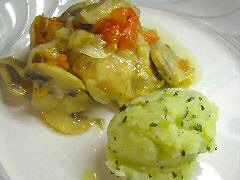
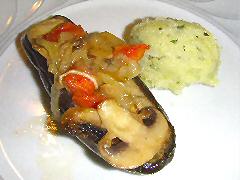
I went through a couple of different recipes for this one. In the end it’s a slightly deconstructed version of the combination that I came up with, and quite simple. In a pot, sauteed lots of chopped yellow onions, then added sliced mushrooms, and cooked until they’d released a good amount of their water. To that I added diced tomatoes, and then put skinless chicken thighs that had been rubbed with olive oil and coarse salt and left to sit for a couple of hours, into the mixture – no additional liquid, between the vegetables and the fat and liquid from the chicken, there turns out to be plenty. Bring to a boil, cover the pot, and let simmer away for half an hour or so, until the chicken is cooked… which turned out to be a strange, and rather embarassing issue on the second of the three nights, when, for whatever unknown reason, about half the chicken thighs were rare on the inside. Unfortunately I didn’t know it until the plates started coming back from the table with several pieces only partially eaten. My best guess is that sitting in the refrigerator, the pieces that were at the back froze – which seems to happen to things at the back of my refrigerator, and they simply hadn’t had a chance to cook through after thawing in the pot by the time the other pieces were done cooking. Yikes, no?! On the right, the same preparation but with eggplant instead of chicken, as on two of the nights we had a request for a vegetarian entree – an easy substitute here, just a separate small cooking pot and everything else the same – other than a little extra olive oil and a splash of water to make sure there was enough liquid.
The “deconstructed” part came from the original idea to include diced potatoes and chopped garlic, and finish with a bit of lemon juice squeezed over the top plus some chopped mint. Instead, I made mashed potatoes and finished them by mixing with part butter and part olive oil that were pureed together with the juice and peel of a lemon, and a few garlic cloves, and then at the last moment mixing in a large amount of fresh chopped mint (don’t do it too early or the mint will turn black).
 Cherries just came into season, and my fruit and vegetable purveyor came up with a case of beautiful plump Patagonian cherries for me to use. At first glance… really just the title… the Vişneli Ekmek Tatlisi was a perfect choice – a sour cherry bread pudding. Only using sweet cherries. And then reading the recipe and finding that the “pudding” was no more than a slice of plain bread that was either fried or baked until brown and almost crisp, topped with sour cherries stewed in sugar syrup. On the flip side, I didn’t feel like making an actual cherry bread pudding, so instead I just took the idea a different direction with a different bread – some fresh brioche – and topped those with the hot stewed cherry mixture (2:1 pitted cherries to sugar, and just a splash of water), and a little whipped cream. The brioche is a simpler version than what might be done, but it comes out really tasty, and true to the spirit – and makes brioche something that you could actually consider making regularly at home. It still requires a bit of patience and time, but not near as much as a traditional approach.
Cherries just came into season, and my fruit and vegetable purveyor came up with a case of beautiful plump Patagonian cherries for me to use. At first glance… really just the title… the Vişneli Ekmek Tatlisi was a perfect choice – a sour cherry bread pudding. Only using sweet cherries. And then reading the recipe and finding that the “pudding” was no more than a slice of plain bread that was either fried or baked until brown and almost crisp, topped with sour cherries stewed in sugar syrup. On the flip side, I didn’t feel like making an actual cherry bread pudding, so instead I just took the idea a different direction with a different bread – some fresh brioche – and topped those with the hot stewed cherry mixture (2:1 pitted cherries to sugar, and just a splash of water), and a little whipped cream. The brioche is a simpler version than what might be done, but it comes out really tasty, and true to the spirit – and makes brioche something that you could actually consider making regularly at home. It still requires a bit of patience and time, but not near as much as a traditional approach.
Bread of the evening – our basic olive oil bread topped with nigella, or black onion seeds, and served with mint butter.